After sacking head coach Niko Kovac, Bayern Munich promoted their assistant coach Hansi Flick to the head coach position.
And after remarkable improvements in terms of playing style and results, they gave Flick a contract until 2023.
Under Kovac, Bayern created 2.20 xG while allowing 1.26 xGA and scored 2.67 goals while conceding 1.43 goals per game on average. I
n comparison to that, Flick managed an average xG value of 2.51 per game with the xGA value being 0.93 and his side even scored 3.19 goals on average while conceding only 0.85 goals per game.
This clear improvement in every of these metrics underlines the influence of the managerial change.
As we will explain in our analysis, these changes are far away from coincidence and cohere with Flick’s tactical tweaks.
In our Hansi Flick tactical analysis, we will examine the main facets of Flick’s Bayern tactics in order to find out what makes them so successful after their struggles under Kovac.
Hansi Flick Tactical Formation & System
Under Flick Bayern mostly lineup in a 4-2-3-1 formation. Below, we can see their lineup from their Champions League game against Chelsea.
This displays Bayern’s most frequently used lineup and therewith their key personnel.
The back four consists of the centre-backs Jérôme Boateng and David Alaba, as well as the full-backs Alphonso Davies and Benjamin Pavard.
In front of that, Joshua Kimmich forms a double pivot together with the Spanish midfielder Thiago Alcántara. On the playmaker position, right behind striker Robert Lewandowski, Flick prefers to line up Thomas Müller.
Their attacking department further includes the winger positions, mostly played by Serge Gnabry and Kingsley Coman.
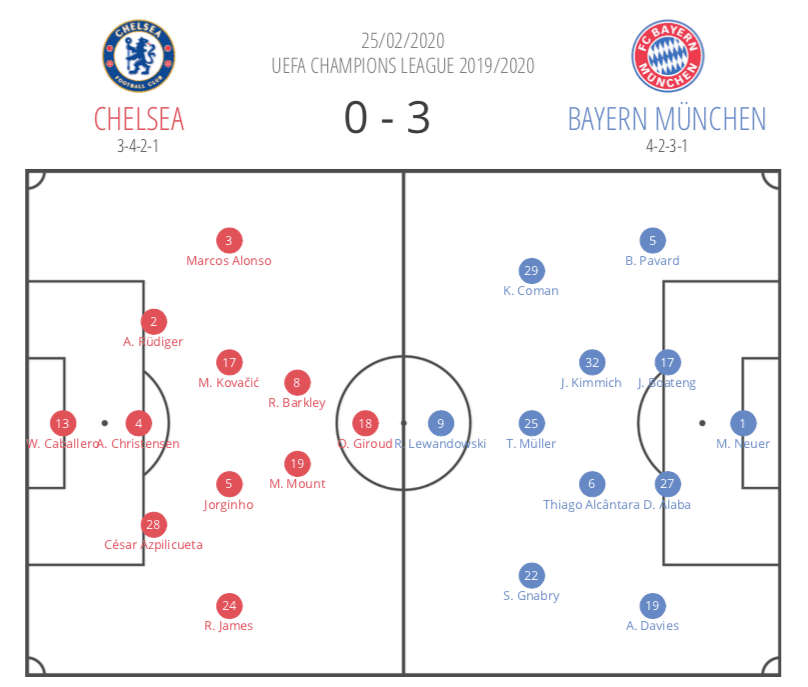
Nevertheless, Bayern obviously have some other players that provide a lot of quality as well. Ivan Perišić also often plays as a left winger, while Leon Goretzka is another option for a position in their double pivot. And in the back line, Lucas Hernández and Niklas Süle can play as centre-backs. But both of them suffered with injuries during this season.
When Bayern are in possession, their full-backs will push higher up the pitch and provide width on the flanks. Meanwhile, the wingers often tuck inside and occupy the half-spaces. Left-back Davies (#19) naturally takes up a higher role while right-back Pavard (#5) will sometimes stay deeper. The latter one only moves up the pitch when the ball is being progressed up the pitch on his side. As a result, their attacking shape is often asymmetrical, like displayed in the graphic below.
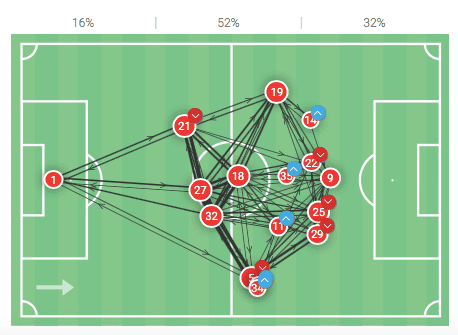
The central midfielders will often act in different roles. In this case, Kimmich (#32) often dropped into the back line to create a back three in possession while Goretzka (#18) stayed in a central area in front of the back line. In other matches though, Bayern build up only with the two central defenders. Despite this changes depending on the opposition, their overall goal to penetrate the opposition goal in central areas remains the same. For this example, it can be seen when depicting how much passes Bayern played within or into the centre or half-spaces.
Bayern’s attacking tactics under Flick
Under Hansi Flick, Bayern’s build-up play is versatile. They either build up with a back three or only the two central defenders, as mentioned before. Once having progressed up into the opposition half, their full-backs push up into the final third. With the attacking trio providing width within the centre and the half-spaces, Bayern often provide an attacking line of five players. With Müller roaming behind or between them, the opposition are often pinned deep down in their own half. From then on, Bayern often use an attacking shape that resembles a 2-3-5 or 3-2-5 depending on the opposition.
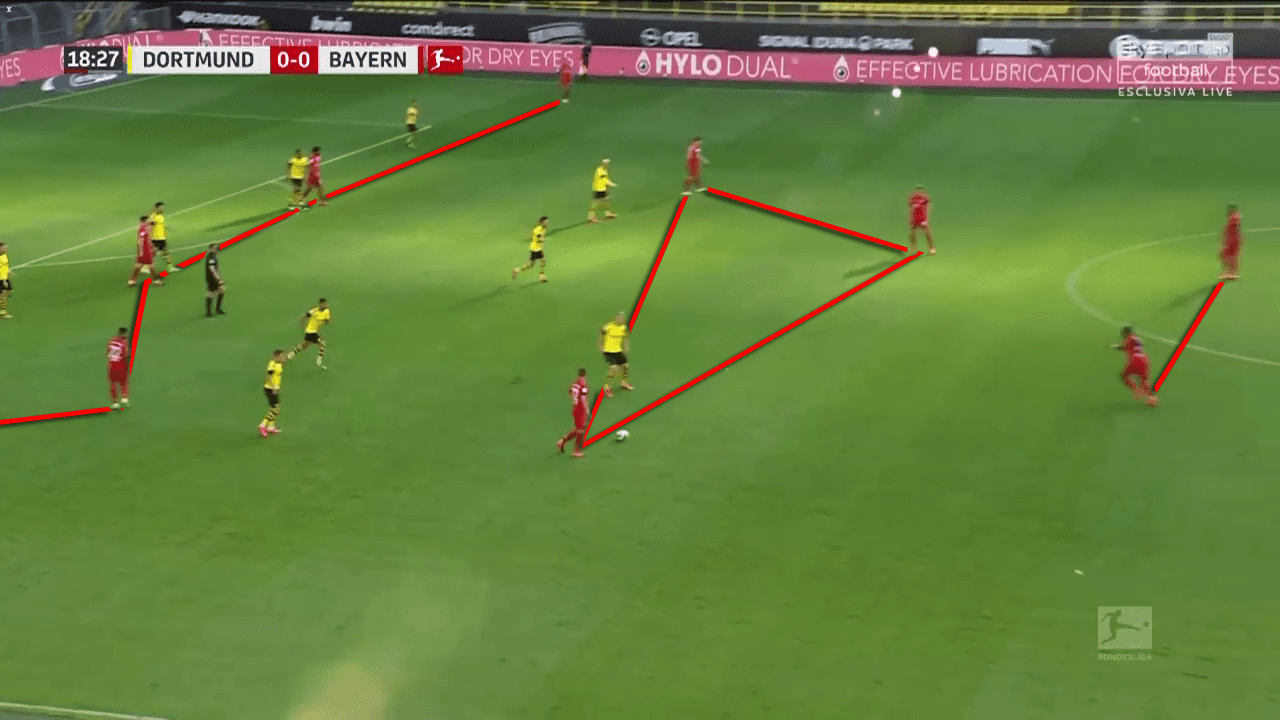
As a part of the double pivot, Joshua Kimmich is one of Bayern’s key players under Hansi Flick. Whereas Kovac often lined Kimmich up as a right-back, Flick banks on Kimmich and his skill set in central midfield. From this area, he can dictate play and use his vision as well as his passing abilities to initiate attacks. Below, we can see him playing a pass into the final third and therewith initiating a dangerous attack.
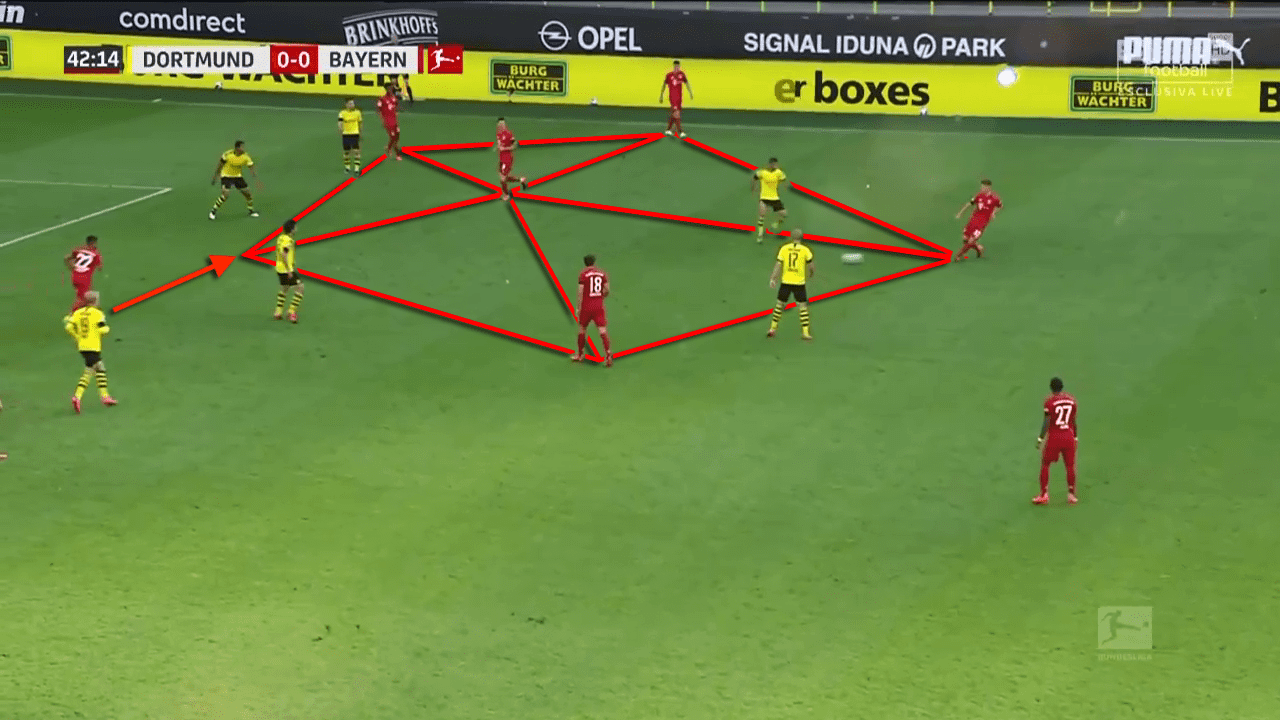
The above displayed image also shows an overload. They shift towards the ball with several players and occupy the ball near flank and half-space with six to seven players. That either enables them to create a numerical superiority or forces the opposition to commit many players towards this side. In the first case, Bayern can utilise their superiority to penetrate the opposition defence. And in the latter case, they could switch play and attack free spaces on the ball far side.
An important player when it comes to attacking movements is Thomas Müller. His abilities as a “Raumdeuter” (what directly translated means “space interpreter”) are experiencing a renaissance since Flick took over. Müller is extremely important in terms of chance creation. With 24 assists in all competitions and an additional 11 goals that he scored himself, Müller is of huge importance for Bayern in the attacking third. Müller likes to drift into areas where he can create overloads for his side such as the half-spaces or even the wing. Therewith he opens up space for attacker Lewandowski, or the wingers who then move inside.
And, he is also capable of recognising free space or gaps that can be exploited. In the following scenario, for example, he assists a goal after exploiting a gap within the opposition back line.
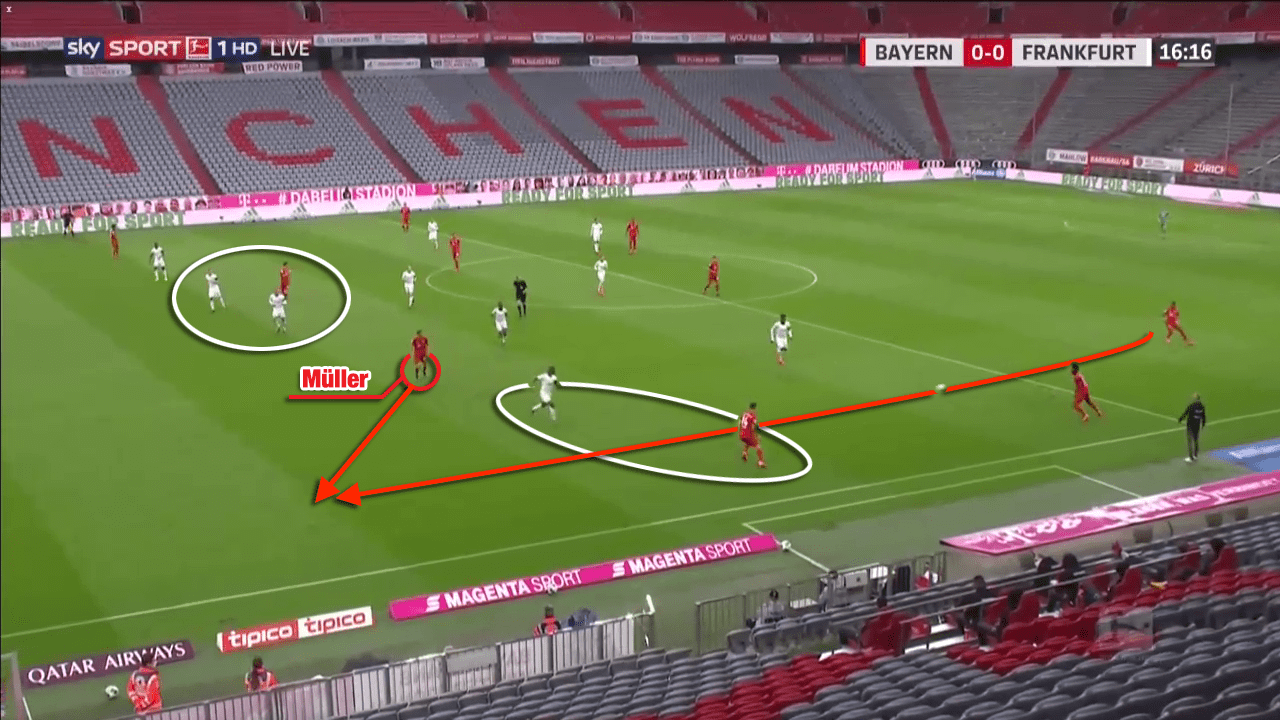
Another interesting feature of Flick’s Bayern is the offensive contribution of their full-backs. With completely different skill sets, left-back Davies and Pavard both enrich their team. While the right-back rather uses his passing abilities during the early build-up stage playing in deeper areas, their left-back Davies likes to move up the pitch and threaten the opposition back line with his progressive runs.
What makes Bayern hard to defend is their attacking fluidity as well. On the last line, Bayern’s players interchange positions and act on slightly different lines. This makes it hard for the opposition back line to adjust the height. When the ball-carrier is facing forward, there will always be a Bayern player making a deep run. As the opposition defenders are confronted with several attacks, they are overwhelmed by the different reference points. As a result, they can be caught in bad positions with through passes or chipped balls in behind such as in the situation below.
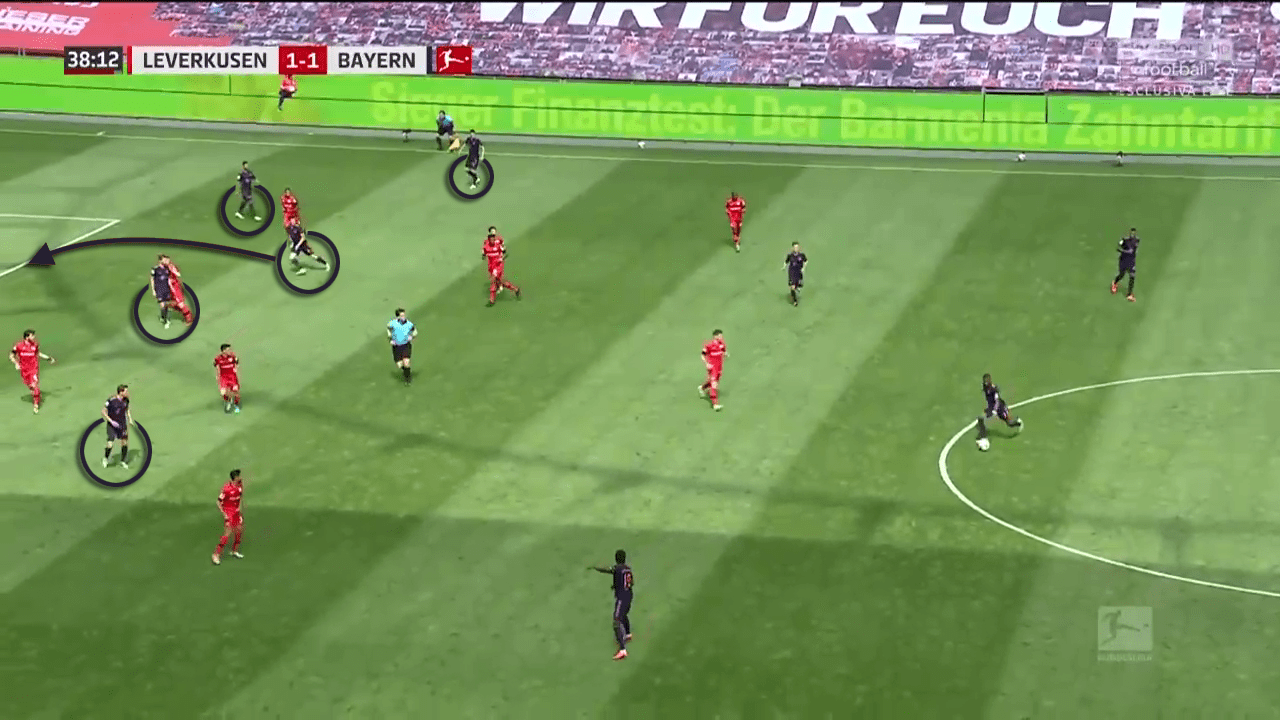
Improved structure allows for effective Gegenpressing
Another main aspect of Flick’s Bayern is their improved Gegenpressing. Whereas Kovac preferred a wide structure, often with a U-shape in possession, new head coach Flick likes his men to keep the passing lanes short and therewith also provides a more narrow shape. As a consequence, if Bayern lose the ball, the distances towards the ball and possible ball near passing options are shorter which enables them to execute an effective Gegenpressing. Especially their overloads help them to immediately press the opposition ball-carrier after losing the ball.
A shorter distance to the ball-carrier also means that the pressing player can cover more space with his cover-shadow. In the image below, Coman can therefore take two Frankfurt midfielders out of play. And with the forward options blocked by Bayern’s defensive triangle, the ball-carrier is forced into a bad pass which gets intercepted.
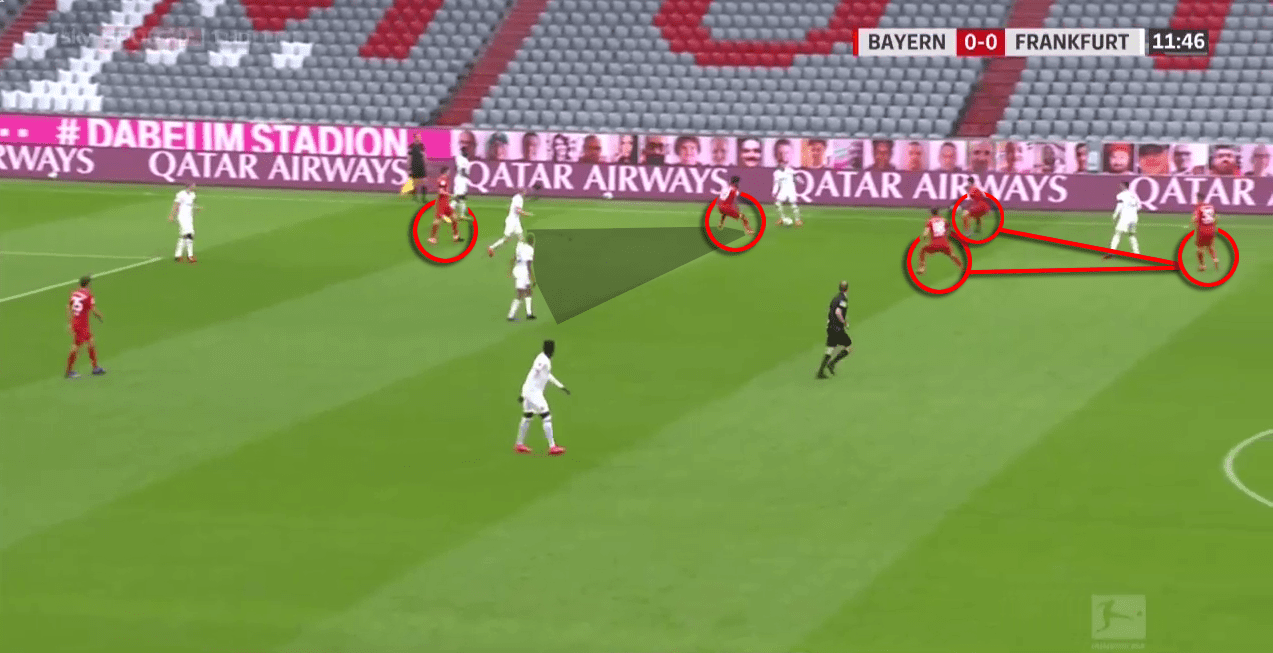
Also, they can win second balls or rebounds after crosses due to their structure. Even before the opposition can regain possession, Bayern use their shape to win a lose ball and therewith remain the team in possession. While they provide width in the attacking department, their 2-3-5 / 3-2-5 shape allows for a compact shape in central midfield. And as the midfielders progress up the pitch whenever they send in crosses from wide areas, their midfielders are capable of winning rebounds such as in the scenario shown below.
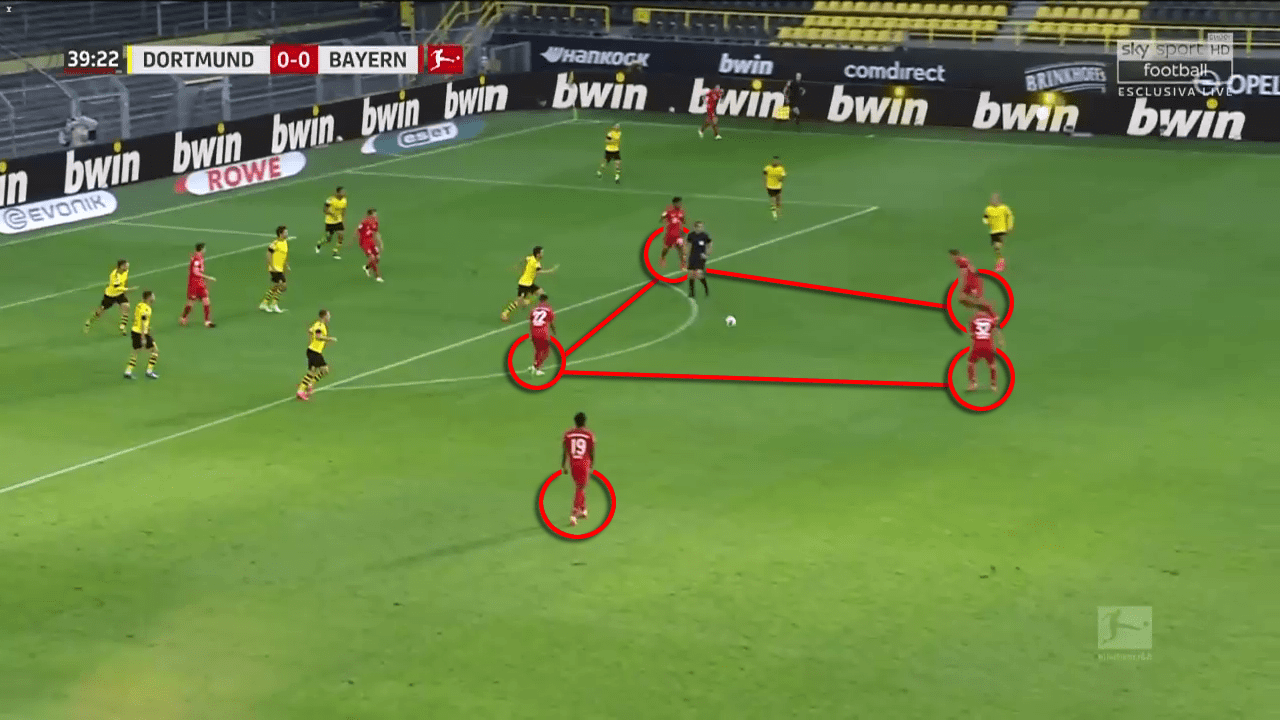
Winning the ball back in these moments allows them to catch the opposition in a moment where they start transitioning from defence to attack which allows for good counter-attacking opportunities.
More dominance due to a higher press
Furthermore, there has also been a clear change in terms of the pressing style under Flick. Whereas the side did not always press high under Kovac, they now actively press the opposition high up the pitch. They use a rather man-oriented approach when the opposition have a goal-kick and try to regain possession high up the pitch or force them into playing imprecise passes that can be intercepted.
In order to do so, they even take the courage to defend man against man all over the pitch when the opposition play out from a goal-kick. Defending man against man within the back line, also requires the physical attributes of the defenders to defend the space behind the back line in case of a long ball. This is probably one of the reasons for Flick’s choice to play with Alaba as a centre-back since the Austrian has got the pace to keep up with opposition attackers which enables him to either stop the attacker or allow his teammates enough time to track back.
While striker Lewandowski shuts down one centre-back, central offensive midfielder Müller usually presses the other one. By using his cover-shadow, he can prevent a pass to the midfielder he initially marked before Bayern start to press. And if the opposition provide a double pivot to overload Müller, Bayern commit a further central midfielder forward to mark this player. However, there is always one midfielder remaining in front of the back line. This midfielder covers for the pressing midfielders and positions himself for possible second balls in case the opposition play the ball long. You can see such a pressing situation in the next image.
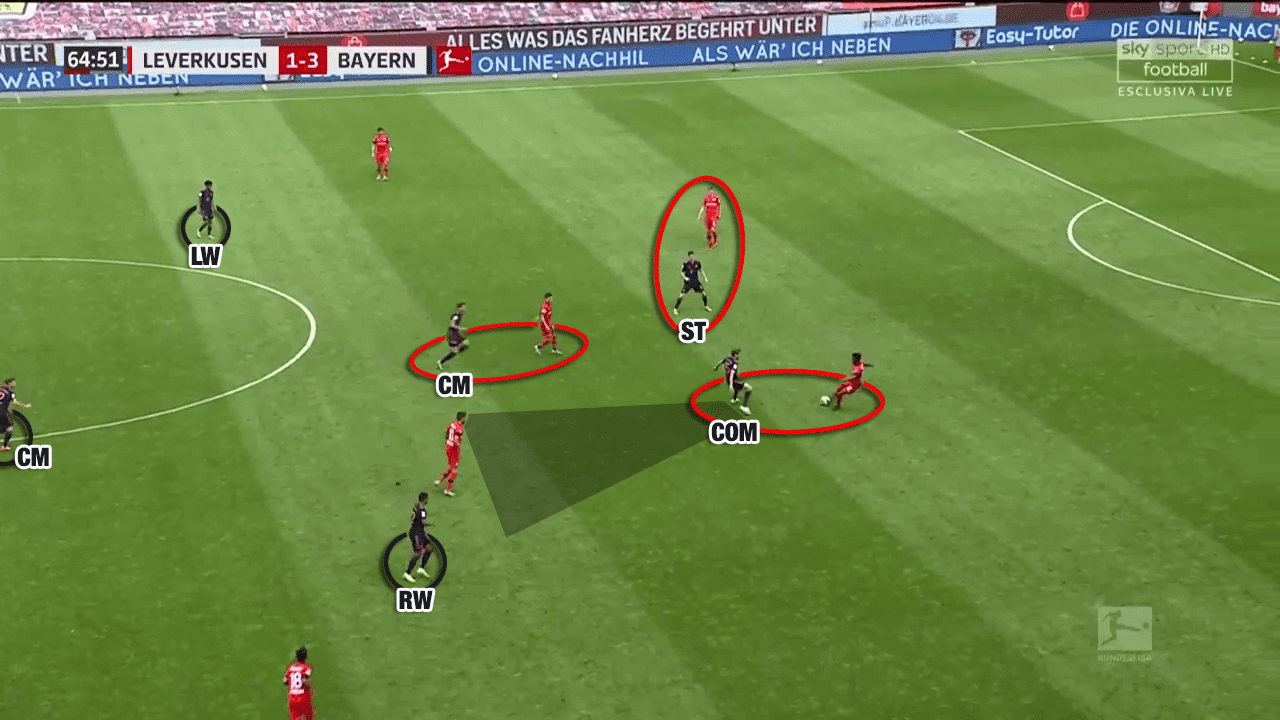
Their wingers always stay inside of the full-backs ready to press them if they receive the ball or to support the press in the centre. That way, they are also ready for counter-attacks and to quickly start into the gap between central defender and full-back.
This increased pressing leads to a higher dominance throughout most of their games compared to their matches under Kovac.
Counter-attacking
Besides the dominance, their high press obviously also creates counter-attacking opportunities.
When winning the ball with their press, they benefit from the positioning of their pressing players. Having pressed their direct opponents they are directly able to transition from defence to attack. Therefore, they can sometimes even overload the opposition back line. Furthermore, their attackers provide options for the ball-carrier to penetrate the opposition defence with through passes.
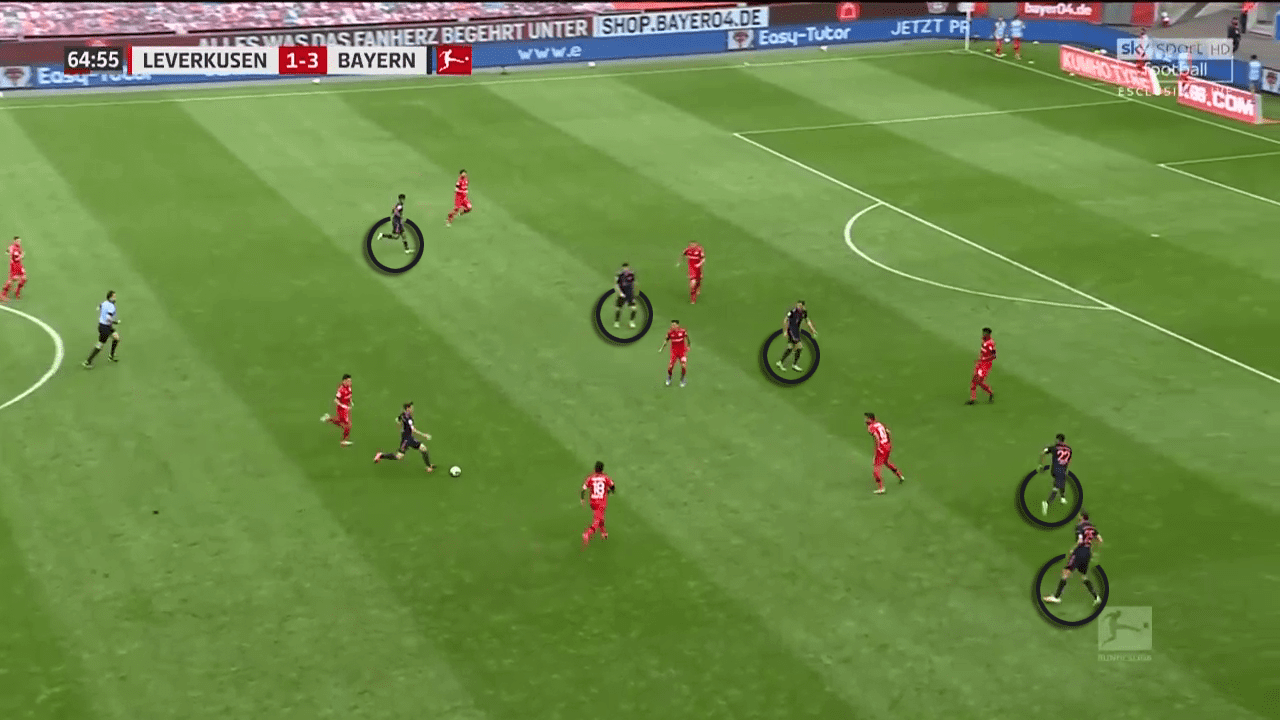
With Bayern’s fast wingers, they have the required attacking personnel to play these through balls. Ideally, they look for the direct way towards the goal to finish their counter-attack.
Nevertheless, if they are forced out wide, they will use this to put in crosses.
Lewandowski as the target man for possible crosses delays his runs for ideal timing and uses blind-side runs to receive the ball in the box.
Moreover, with further players joining the box such as Müller or Goretzka who can also be threatening in the air, Bayern’s crosses can be a true weapon.
Conclusion
All in all, as shown in our Hansi Flick style of play analysis, Bayern have shown clear improvements in all phases of the game under Flick.
The philosophy of the German coach consists of a positional play with full-backs that support the attack.
Moreover, Flick could improve Bayern’s counter-pressing through simple yet effective changes of their attacking structure.
And, last but not least, his Bayern side press with a high intensity which increases their dominance and also gives them opportunities for threatening counter-attacks.
It is only a matter of time until Bayern Munich can claim themselves Bundesliga 2019/20 winners.
And with their current form it would have also been interesting to see how they would perform in the further stages of the UEFA Champions League.





Comments